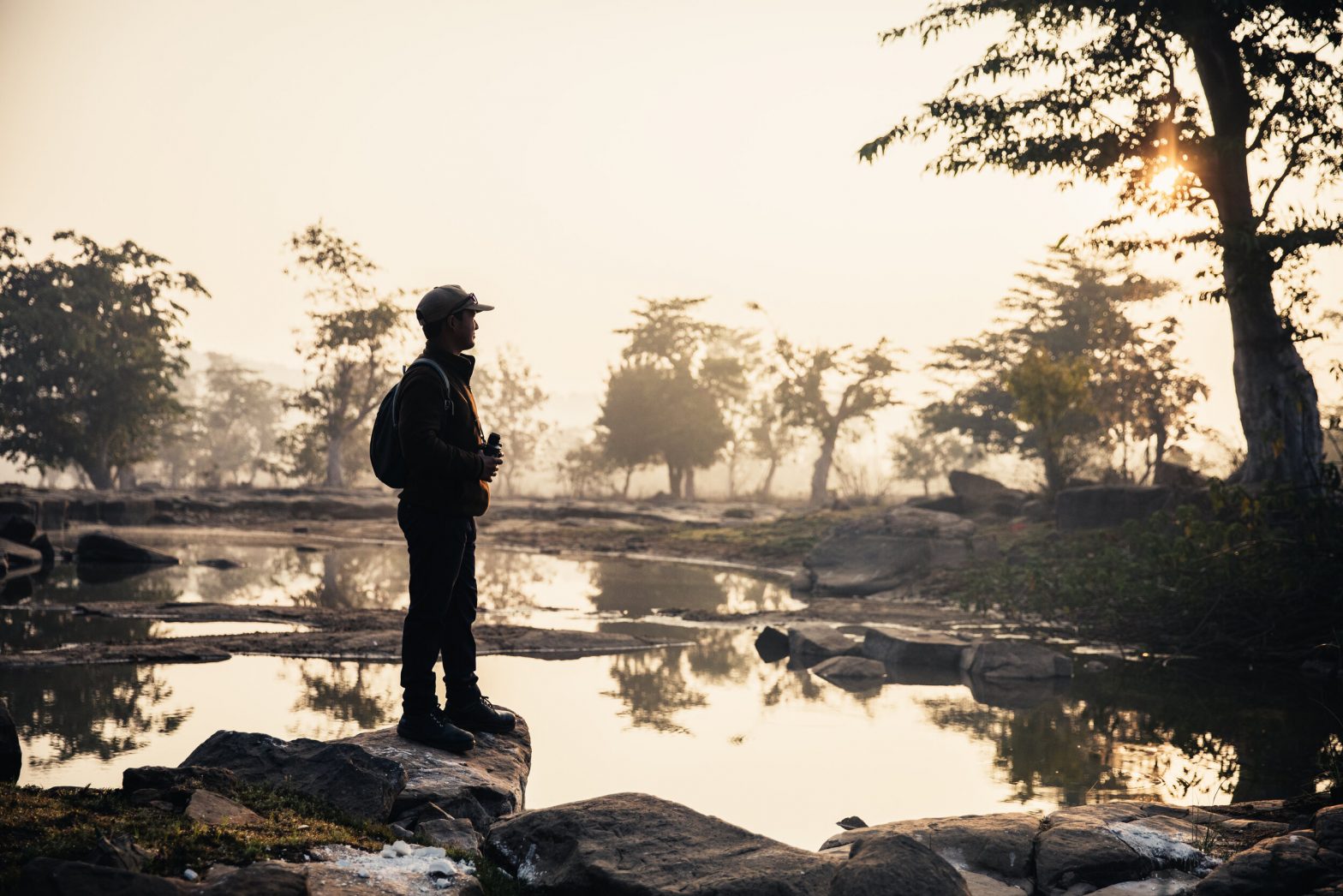In the valley, thick bamboo sticks shoot up around us from the earthy undergrowth. Their vivid-green leaves lace into a natural parasol that shades us from the midday sun, as we crouch down to inspect the ground for animal tracks. Badda points out a faint scuff in the dirt, almost invisible to the untrained eye, and follows its direction to a nearby tree. The gnarled trunk is covered with fresh scratch marks.
“A leopard was just here,” he whispers, running his palm over the rough indents. Sure enough, he finds a fragment of a claw, not much bigger than a fingernail, embedded in the bark. As we move on and begin a steep climb up a forested, rocky hill, a not-too-distant, alien sound – somewhere between a roar, a howl and a bark – ricochets between the surrounding gorge’s rocky walls. I can tell from the knowing smiles of my companions that it’s the sound of a wild, big cat, of the unmistakable golden and black-spotted variety. Badda puts his hands to his mouth and imitates the roar, calling back through the trees, pitch perfect.
I’m on a day-long trek through the jungles of Panna National Park, a protected area of India’s eastern Madhya Pradesh state. The 1600sqkm reserve draws visitors for one valuable reason: its native big cats. And although I’ve found myself within prowling-distance of a leopard, I’ve got my eye on an even bigger prize. Tigers roam this landscape, and one community here knows how to track them like none other.
The indigenous Pardhi (meaning ‘hunting’) tribe, Badda among them, has lived nomadically in this area for five centuries, its people sustaining themselves through foraging and hunting wild boar, birds and other animals. Their unique skill is an uncanny ability to mimick animal calls. If anyone could help me navigate these backwaters and plains – and fend off the sloth bears, snakes, big cats and hyenas along the way – it would be these guys.
Badda is one of 16 Pardhi people to be involved with the Walk with the Pardhis expeditions, which are run from Pashan Garh lodge – a luxury-safari outpost of the Taj Hotels brand, and the starting point for our day. The project was launched in 2018 by Taj Safaris, wildlife conservation programme Last Wilderness Foundation and the Indian government’s Panna Forest Department, and has expanded to other hotels in the Panna region since. No longer able to support themselves by hunting in the protected national park, the once-nomadic tribe (communities of which are found all over India) now use their unparalleled tracking talents to offer guests an immersive wilderness experience, via Taj Safaris’ training programme.
The morning of our walk starts before sunrise. Over a steaming cup of chai tea, I sign a mildly worrying waiver – one that absolves the hotel from blame if I fall victim to the ‘real risk of bodily harm by dangerous animals’. As I do so, the hotel’s on-site naturalist, Dipu Kumar, races into the room to tell me that a tiger was just seen stalking through the lodge site. It’s the second time in four days. We rush outside to see deep paw prints pressed into the sandy forest floor, just metres from where we were sitting. Hearts pounding, we agree that it’s time to meet up with the Pardhis.
By the time we reach the meeting point, on a dusty road dotted with small settlements in the outer ‘buffer’ boundary of Panna Tiger Reserve, the sun is high enough to hit the tips of the treetops with shafts of golden light. We set off through a sandy plain, heading towards the cavernous Ranipur gorge, which we’ll climb down before entering the jungle proper and scaling the Jumanji-size peak by sundown. A walk is generally escorted by five or six Pardhi people – today we’ve got Badda, Batal, Reshna and Lallarsi, all with the surname Pardhi – but we’re also joined by the Taj Safaris area manager Nagendra Hada and Bhavna Menon, programme manager of Last Wilderness Foundation, which facilitates Pardhi community outreach.
We’ve been walking for just a few minutes before Badda begins to point out signs of wildlife, big and small: hours-old hyena tracks, identifiable by their garlic clove-shaped claws; the teeny paw prints of field mice; a caterpillar trail that resembles a miniscule tyre track. Batal points out medicinal plants that have been used by the Pardhis for centuries – the community is still reliant on ancient herbal remedies and witch doctors.
We chew on Ketha leaves, a herbal mouth freshener that tastes like aniseed, and run our fingers through the leaves of a Mahua tree, whose pink flower petals can be dried and crushed into the favoured local hooch. Lallarsi strips the red bark off an Ajun tree, to be ground into a tea that treats high blood pressure. Batal rubs Lantana leaves – a natural antiseptic that can be wrapped on wounds – between his palms, releasing a green juice that’s powerful enough to remedy scorpion stings and soothe boils. “You can also put this in your ear to treat tooth problems,” he advises, “but only on Wednesdays.”
The morning is quickly whiled away like this and before we know it it’s time to prepare lunch, by a jade-green river in the middle of the gorge. Water buffalo laze around us, electric-blue kingfishers swoop overhead and a family of langoon monkeys watch with interest as the Pardhis boil rice in fresh river water and crush gooseberries and coriander into chutney on a large, flat rock.
As we wait, I’m treated to a demonstration of Pardhi animal calls. Lallarsi roars like a jackal and barks like a monkey, to everyone’s hilarity, before imitating mating calls between a peacock and a peahen with Badda. Batal whistles to a partridge perched on a nearby branch – which tweets in reply – before performing the guttural, threatening growl of a tiger. He reveals that the very ground we’re sitting on was the site of a tiger poaching in 2000 – a hunt that he was party to. In fact, all the Pardhi men present have hunted tigers in the past.
They didn’t have many other options. The hunting tribe has been exiled from mainstream Indian society throughout history, notably by British colonial officials, who labelled them a ‘criminal tribe’ in 1871 due to their outlawed existence in the bush – despite exploiting their tracking skills to help them trophy hunt. The tribe was denotified of this label in 1952, but decades of demonisation had made their reputation hard to shift.
Unaccepted by local communities and cut off from the benefits of education and fixed settlements, the nomads continued to support themselves in the only way they knew: by hunting, this time for increasingly valuable species, as a domestic and international appetite for trophy hunting – despite it being illegal in India since the 1972 Wildlife Protection Act – grew in the second half of the 20th century. By no means were the Pardhis the only hunters in Panna, but they were especially good at it, luring tigers into traps with their imitation calls. Tiger numbers dwindled from 23,000 at the time of Indian Independence, before which only British officials and Maharajas were allowed to hunt, to 1,100 by 2006. This was also thanks to habitat loss, from extensive deforestation and the building of human settlements.
“In 2008, the WWF declared tigers extinct in Panna,” says Hada, “and the Pardhis were blamed. Yes, they were involved. But in the last 70 years of independence in India, what had we done for them? We didn’t provide them with education or jobs. People do what they can to survive.”
Batal was the first of his Pardhi community to give up hunting, in 2008, when – convinced by the Forest Department – he became a community advocate for a different way of life. It wouldn’t have been possible without the support of the Last Wilderness Foundation, which had built schools for Pardhi children in the Panna region and hostels for more permanent accommodation. The foundation employed Batal and his wife there to teach the youngsters how to brush their teeth, cut their nails and generally prepare themselves for a life and education in mainstream society. They convinced their whole community to stop hunting for good, which won Batal’s wife a lifetime wildlife award from Sanctuary magazine.
“They’re embarrassed about their past,” says Menon, who’s been managing the Pardhi community outreach programme for nine years. “But we don’t want them to be ashamed of who they are.” The foundation began skills training programmes in the hostels in 2015 and recruited walking guides for Taj Safaris two years later. Now, five families are entirely supported by the Taj programme, and last year, the first Pardhi women were trained up. Reshna, the youngest in our group, was the first girl in her community to leave and work elsewhere. Dressed in crisp khaki safari wear, she’s been trained as a naturalist and now works in a sister lodge in Kahna Tiger Reserve, an eight-hour drive south of Panna and her family. It was revolutionary for the community and has had a huge social impact.
“Reshna’s confidence has really improved,” Menon says. “It’s a big deal that girls like her don’t have to rely on men anymore.” Nomadic life is rare among the Pardhis now, who have settled in villages. But while the older generation worry that the tribe’s heritage will be forgotten, Menon explains that the Walk with the Pardhis programme is actually re-teaching the younger generation the tracking skills that might have been otherwise lost.
After a lunch of lentil daal and slow-cooked potatoes, peas and tomatoes, served on stitched-together banyan leaves with bonfire-baked roti bread, we enter the denser part of the jungle. We pass dark caves that are known leopard dens, see their scratch marks and hear their roars. The path between the trees gets steeper, rockier, more difficult to discern – but the Pardhis know the way. We scramble up rocks and slash through the thicket, squeezing through a narrow crevice that opens up onto a jaw-dropping view of the gorge below.
Our Pardhi guides’ wives are waiting with baskets full of dried spices and rice for our evening meal. We sip on chai as they cook and sing folk songs; melodic, haunting odes to the dramatic landscape around us. The dipping sun casts golden-peach hues as we light lanterns and bonfires and settle in for the evening. “Who needs a five-star hotel?” asks Hada, reclining back to gaze at the twinkling canopy emerging from the night sky. “We’ve got 1,000 stars right here.”
Back in bed at the safari lodge, I lie in the pitch black and listen. Putting my new, Pardhi-style tracking skills to the test, I pick up the rustle of sandy-coloured palm squirrels on the roof and the snouts of wild boars rootling in the undergrowth. So far, so peaceful. Then, I hear a distant, panic-stricken series of barks. It’s a family of langoon monkeys, warning of approaching danger. It’s followed by the honk of a sambar deer, prey to the biggest cat of all, and one that’s eluded us all day.
No tigers have been poached in Panna since 2008, when eight were reintroduced from other national parks. Today, India has an estimated 3,967 tigers and the reserve is home to 55 of them, in large part thanks to the Last Wilderness Foundation’s work to reintegrate the Pardhis into mainstream Indian society. “When tigers, tribes and tourists come together, the future for tigers – and people – is bright,” Hada had told me earlier.
As the monkeys’ calls grow more frenzied, I hear a distant, guttural roar. It’s indistinguishable from the sounds made by Batal and Badda, but there’s no mistaking the animal that made it. With the Pardhis on the tigers’ side, I feel confident that this sound will resonate through these jungles for a long time to come.

